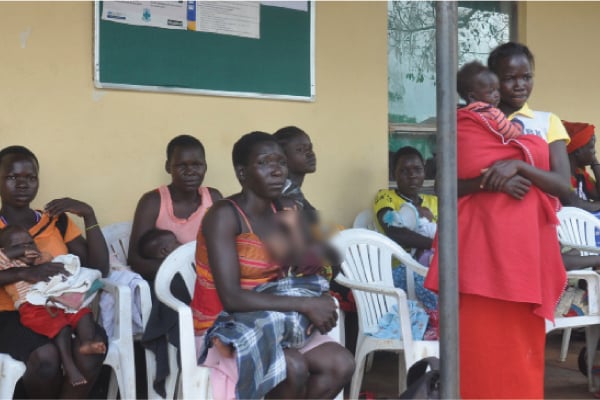Study ranks Uganda top with cases of childhood cancer linked to malaria

Women queue with their children at Kocgoma Health Centre III in Nwoya District last August. Child cancer cases in northen Uganda have steadily grown over the past two years, according to health experts. PHOTO/TOBBIAS JOLLY OWINY
What you need to know:
- A previous study in 2020 by researchers from the St Mary’s Hospital Lacor also showed that “children with asymptomatic parasitaemia/antigenaemia (silent malaria) may be the population at risk of eBL.”
A study in three East African countries has ranked Uganda as having the highest incidence of aggressive childhood cancer, endemic Burkitt Lymphoma, which is linked to repeated malaria infections.
The study report was authored by researchers from St Mary’s Hospital Lacor and colleagues from America’s National Cancer Institute and universities in Kenya and Tanzania. It was published in 2023 in a scientific journal, Proceedings of the National Academy of Sciences (PNAS).
“Overall, the average endemic Burkitt Lymphoma (eBL) annual incidence for the three countries combined was 9.4 cases per million person-years. eBL incidence was 1.7 times higher in males than females; and incidence in Uganda was 1.8 times that of Kenya and 5.3 times that of Tanzania,” the researchers said in the report. Between 2010 and 2016, there were 267 cases of eBL in Uganda, Kenya (183) and Tanzania (102), according to the report.
The researchers further stated that “Overall, children who attain roughly 100 or more infections experience an elevated risk for eBL; however, few children below 5 years attain this considerable number of infections.”
According to the report, the number of infections varied significantly among the countries and age groups.
“In 2012, the average 10 year-old had 61, 40, and 201 infections in Kenya, Tanzania, and Uganda, respectively. This changed to 33, 32, and 176 infections in 2014 and 36, 25, and 162 infections in 2016 in Kenya, Tanzania, and Uganda, respectively,” the researchers indicated.
Dr Nixon Niyonzima, the head of research at the Uganda Cancer Institute, told this publication the report doesn’t provide “new information” about the link between malaria infections and eBL –a curable cancer that manifests with jaw swelling and abdominal swelling.
However, the researchers said their analysis has several strengths that distinguish it from earlier investigations of the link between malaria and eBL. They (researchers) cited using “fine-scale, high-quality, large-area malariometric (endemic level of malaria infection) data” to perform “a larger, in-depth comprehensive longitudinal assessment of the relationship between P. falciparum (malaria parasite) exposure and eBL than has been possible to-date.”
A previous study in 2020 by researchers from the St Mary’s Hospital Lacor also showed that “children with asymptomatic parasitaemia/antigenaemia (silent malaria) may be the population at risk of eBL.”
The researchers recommended the promotion of malaria preventive measures such as sleeping under insecticide-treated mosquito nets and indoor residual spraying. Information from the Uganda Cancer Institute indicates that of an average of 1700 new patients presenting with cancer each year, up to 700 (40 percent) are children.
The exact mechanism through which malaria infection plays a part in the onset eBL is still a big issue among scientists. According to a 2019 study report by Thirumalaisamy P. Velavan from Germany’s Institute of Tropical Medicine, “malaria is not a direct trigger of eBL, but infection rather modifies the lymphoma phenotype (properties of cancer that begins in white blood cell) and the onset of eBL.”
A previous study in 2016 by David Thorley-Lawson of America’s Tufts University School of Medicine, argued that “P. falciparum (malaria parasite) is a risk factor for eBL because it drives a high throughput of cells infected by [a common cancer-causing virus] Epstein-Barr virus (EBV)…leading to Deoxyribonucleic Acid (DNA) damage…and lymphoma.”



